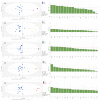Determining the Authenticity of Spirulina Dietary Supplements Based on Stable Isotope and Elemental Composition
- PMID: 36766091
- PMCID: PMC9914286
- DOI: 10.3390/foods12030562
Determining the Authenticity of Spirulina Dietary Supplements Based on Stable Isotope and Elemental Composition
Abstract
While the demand for Spirulina dietary supplements continues to grow, product inspection in terms of authenticity and safety remains limited. This study used the stable isotope ratios of light elements (C, N, S, H, and O) and the elemental composition to characterize Spirulina dietary supplements available on the Slovenian market. Forty-six samples were labelled as originating from the EU (1), non-EU (6), Hawaii (2), Italy (2), Japan (1), Portugal (2), Taiwan (3), India (4), and China (16), and nine products were without a declared origin. Stable isotope ratio median values were -23.9‱ (-26.0 to -21.8‱) for δ13C, 4.80‱ (1.30-8.02‱) for δ15N, 11.0‱ (6.79-12.7‱) for δ34S, -173‱ (- 190 to -158‱) for δ2H, and 17.2‱ (15.8-18.8‱) for δ18O. Multivariate statistical analyses achieved a reliable differentiation of Hawaiian, Italian, and Portuguese (100%) samples and a good separation of Chinese samples, while the separation of Indian and Taiwanese samples was less successful, but still notable. The study showed that differences in isotopic and elemental composition are indicative of sample origins, cultivation and processing methods, and environmental conditions such that, when combined, they provide a promising tool for determining the authenticity of Spirulina products.
Keywords: Arthrospira spp.; Spirulina; authenticity; dietary supplements; elements; geographical origin; quality; stable isotope ratio.
Conflict of interest statement
The authors declare no conflict of interest.
Figures





Similar articles
-
Characterization of Algae Dietary Supplements Using Antioxidative Potential, Elemental Composition, and Stable Isotopes Approach.Front Nutr. 2021 Feb 5;7:618503. doi: 10.3389/fnut.2020.618503. eCollection 2020. Front Nutr. 2021. PMID: 33614692 Free PMC article.
-
Authentication of Indian Honey Based on Carbon Stable Isotope Ratio Analysis-Verification of Indian Regulatory Criteria.Foods. 2025 Apr 8;14(8):1289. doi: 10.3390/foods14081289. Foods. 2025. PMID: 40282691 Free PMC article.
-
Carbon and hydrogen stable isotope ratios of carotenoids and beta-carotene-based dietary supplements.J Agric Food Chem. 2008 Jun 11;56(11):4198-204. doi: 10.1021/jf8002575. Epub 2008 May 14. J Agric Food Chem. 2008. PMID: 18476701
-
Authentication of pure L-leucine products manufactured in China by discriminating between plant and animal sources using nitrogen stable isotope technique.J Food Sci. 2013 Mar;78(3):H490-4. doi: 10.1111/1750-3841.12041. J Food Sci. 2013. PMID: 23458748
-
Impact of Noodle Formulation, Boiling Methodology and Their Interactions on Stable Hydrogen and Oxygen Isotope Ratios.Foods. 2024 Mar 21;13(6):959. doi: 10.3390/foods13060959. Foods. 2024. PMID: 38540949 Free PMC article.
References
-
- Charlebois S., Schwab A., Henn R., Huck C.W. Food Fraud: An Exploratory Study for Measuring Consumer Perception towards Mislabeled Food Products and Influence on Self-Authentication Intentions. Trends Food Sci. Technol. 2016;50:211–218. doi: 10.1016/j.tifs.2016.02.003. - DOI
-
- Moreira A.P.L., Gobo L.A., Viana C., de Carvalho L.M. Simultaneous Analysis of Antihypertensive Drugs and Diuretics as Adulterants in Herbal-Based Products by Ultra-High Performance Liquid Chromatography-Electrospray Tandem Mass Spectrometry. Anal. Methods. 2016;8:1881–1888. doi: 10.1039/C5AY02408K. - DOI
-
- Wu D., Nie P., Cuello J., He Y., Wang Z., Wu H. Application of Visible and near Infrared Spectroscopy for Rapid and Non-Invasive Quantification of Common Adulterants in Spirulina Powder. J. Food Eng. 2011;102:278–286. doi: 10.1016/j.jfoodeng.2010.09.002. - DOI
Grants and funding
LinkOut - more resources
Full Text Sources
Miscellaneous

